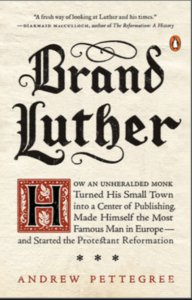Lecture 2. Religious Networks in the Reformation Era
A rainy Tuesday evening greeted Professor Hempton’s second lecture, Religious Networks in the Reformation Era. Shortly after reinforcing the important sporting event referred to yesterday, Hempton explained that this lecture focuses on well-known movements in the 16th Century- the Protestant Reformation networks and the Jesuit missionary organisation. Yet the analytical framework of Networks, Nodes and Nuclei, enable us to study these movements from fresh, interconnected lenses. Below is a summary of the lecture, followed by a video recording and a response from PhD candidate in the History of Christianity, Rev Matthew Baines.

‘[I]n the sixteenth century, religious ideas intersected with other macroscopic changes in print and culture, commerce and social structure, education and civic engagement, and early modern globalization to produce changes of epochal importance. These changes do not easily yield their causes and consequences to analyses of singular religious traditions in particular nation-states or geographical regions. Connecting the networks, identifying the nodes, and dissecting the nuclei at least allows for a wider range of analytical possibilities and helps guard against the Catholic and Protestant propagandized versions of religious history in the Reformation era.’
The Protestant Reformation was the second network that transformed the early modern world. Following the commencement of the Iberian Empire, the Reformation is termed a “religious virus” by Niall Ferguson in his 2018 The Square and the Tower: Networks and Power, from the Freemasons to Facebook. This virus ‘disrupted an ancient ecclesiastical hierarchy, fractured into many pieces Europe’s Catholic Christianity, and ushered in a long era of violent conflict that left few places unaffected.’ Yet Hempton wishes to stress that this virus was only transmittable through its latching onto the new technology of printing, which opened up avenues beyond the original aim of the original Reformation intent, namely large-scale political disruption, the Scientific Revolution, and the Enlightenment. The rhetoric of a unified society under Catholicism broken by the large Reformation event ‘underestimates the perpetual processes of negotiation between local reform efforts and re-establishment within the church, universities, and monasteries.’ Hempton reminds us that the original node of the Reformation was led by Martin Luther from a relatively unimportant town in Northeastern Germany in 1517. In reality, it was the interaction of reformed ideas with the context of the time that allowed for their successful propagation.

The use of the printing press was so important t Luther’s mission Hempton borrows Pettegree’s term of “Brand Luther.” The constant (pre-copyright) reprinting of the writings, and importantly- the hymns of a little-known Augustine friar sparked a revolution of faith. The symbiotic relationship here is key, the printing press elevated Luther, but Luther also crafted his writings for the success of the print. Reflecting on this relationship from a question at the lecture about the transactional process, Hempton reflected on the risk involved in this venture of catching the mood of the time. Where over 5,000 editions of Luther’s works and another 3,000 projects he was instrumental in propagating, including the hugely influential Luther Bible were produced German printers over the 16th Century, whereas the Catholic refutations struggled to disseminate their material (yet still amplified the situation).
The Reformation however was not enacted singularly by Luther and the printing press. As Bob Scribner noted many years ago, the enduring nature of the Reformation relied on it becoming embedded in national identities and contexts, so that the ‘Reformation in England’ became the ‘English Reformation.’ By the second half of the sixteenth century Reformed Churches were present in France, Scotland, England, the Netherlands, Hungary and Poland-Lithuania. In the seventeenth century the colonizing ventures of the early Dutch and English empires implanted Reformed Protestantism to North America and South Africa. The nuclei encouraging Calvin in his Institutes, and his attempt to ‘reconcile Christian freedom with godly order by way of the characteristic Calvinist emphases on divine sovereignty, providence, predestination, and church discipline’ fitted the atmosphere of the time, the most significant element of the context probably being the ‘vigorous anti-Catholicism that was much less tolerant of any accommodation to Catholic rituals than the Lutheran wing of the Reformation.’ The theology of the ‘priesthood of all believers’ was certainly the most contextually important argument against Roman Catholicism that cut challenged rigid structures.
The solidarity, community and connectivity of these Reformed networks also enabled its longevity. Hempton reminds us that ‘the networks sustained by Protestants in the Reformation era consisted of overlapping connections based on print, correspondence circles, schools and universities, and refuges from overt opposition and persecution,’ where solidarity and loyalty where significant elements in their vulnerable resistance. Even more important for radical reformers such as Anabaptists.
In comparison to these powerful Reformation resistance networks, we have The Society of Jesus founded by Ignatius of Loyola and approved by Pope Paul III in 1540. The Jesuit order later become the largest missionary movement in the world and Hempton wishes to highlight the dynamic spirituality (or nuclei) that accompanied their journey. Drawing on the work of Michelle Molina, Hempton explores how new ways of thinking of the self drove this impressive mission that not only spread their religion but raised money, built libraries, educated Europe’s Catholic elites, promoted civic engagement, pioneered scientific inquiry, constructed maps, employed the visual arts and produced any number of grammars, vocabularies, catechisms and confession manuals. What is highlighted about the Ignatian spiritual exercises is how they encourage the participant to see beyond themselves. They aimed to bring together the ‘interior knowledge of Christ with an expansive vision of the redemption of the whole world.’ The practice begins with self-scrutiny, then asks to imagine the life of Jesus, and then to try and bring these together through reflecting on an expansive vision of the whole world, ending with Christ’s passion and death and the resurrection appearances. These exercises confronted the practitioners to reflect on the relation of the divine to the word’s sinful and tainted. Hempton also connects these strong spiritual disciplines to the ability of Jesuit missionaries to enculturate themselves in new cultures, held by the spiritual community that was often far away. Uniquely, they would often mix nationalities in mission fields, allowing them to constantly carry an international identity.

The most well-known legacy of the Jesuit mission is the advancement in education. Yet this project, build on religious philanthropy in a voluntary model came with debt. To counter this, they published their ‘emblem books’ that incorporated illustrations and aimed to enculturate Ignatian piety into the communities and draw up support for the mission from all social classes. Even with inculturation and international diversity being so high on the agenda, connection was so important to this society that the act of sending letters transcended an administrative duty and acted more like a spiritual exercise.
Conflict and controversy between the order and the political atmosphere of the lands it found itself in alongside the ever tightening control of a globally expanding church by the Roman networks, saw the mission stuck in some tricky situations, eventually culminating in national expulsions, bankruptcy, and a Pal Bull in 1773 from Clement XIV. 23,000 Jesuits were thrust into potentially vulnerable positions, with their central base (or node)- Rome, no longer a safe space. Resultingly, ‘most of their properties were seized and their missions abandoned; their educational functions were passed on to other religious orders; and the Society’s Superior General Lorenzo Ricci was incarcerated in Rome and never released.’ Yet their story continued, unexpectantly through survival in the Russian Empire and the United States. This ‘skeleton existence’ allowed them to reform in 1814 with their restoration under Pope Pius VII, with only around 600 informally networked Jesuits remaining. ‘But what the decades of suppression showed is that even without the support of political and ecclesiastical elites, and often their active hostility, the Jesuits were able to survive and in some places thrive by holding fast to their Spiritual Exercises, their educational philosophy, their habits of mind, and their informal and formal networks.’

What these examples demonstrate is that religious networks are dependent on their larger political, cultural, or even theological contexts, but not necessarily dependent on siding with the hierarchical powers. Spiritual links and loyalties sustain these networks through times of trial and brave risks, and aligning themselves to cultural progressions allow them to propagate and spread. On reflection, we may wonder as historians how far we can claim that the Jesuit network post-eradication by Papal Bull is the same as the network before. Similarly, we can wonder how far the thinkers of Luther and Calvin and their movements of resistance are related to their imbedded ecclesial movements today. Yet what we have discovered in this lecture is that the reason for the success of these movements depend on a multiplicity of factors, and singular denominational or national explanations fall short of convincing conclusions.
Response to Lecture 2
A Network Approach to Reformation: Protestant and Catholic
In his first lecture, Professor David Hempton set out the rudiments of his promising new paradigm for understanding the history of Christianity from 1500 to the present day: Networks, nodes and nuclei (I refer to this as “the network approach”). In his second lecture, he applied this paradigm to the first of two networks which transformed the early modern world: the religious and political disruption known as the Reformation. At first glance, it might appear surprising that three-fifths of the lecture discussed the Roman Catholic order of the Jesuits. However, Professor Hempton has perceptively recognised that the reform impetus was not a uniquely Protestant phenomenon and that as the name suggests, the early modern period witnessed a concerted attempt at Counter-Reformation from with the Roman Catholic Church itself. Not to mention the fact that both Protestants and Roman Catholics harnessed the power of the printing press in their reform efforts.
In his discussion of Protestantism, Professor Hempton highlights Martin Luther as one who was singularly successful at using print media to reach a vernacular audience on an unprecedented scale. Here is a helpful reminder that Luther was not merely a catalyst for Reformation but an important nucleus of it. Professor Hempton qualifies his emphasis on the printing press by rightly observing that Reformation ideas – such as the freedom of the Christian, sola scriptura, justification by faith alone and the priesthood of all believers – were promulgated through networks by other non-print media such as letters and oral communication. Turning to the Reformed wing of Protestantism, Professor Hempton recognises that John Calvin’s most famous legacy was his approach to church discipline, motivated by his desire to reconcile Christian freedom with godly order, a project which had a far-reaching impact on the Protestant world. Professor Hempton then turned to the radical wing of Protestantism. Unlike Lutheranism and Calvinism, Radical Protestantism lacked hierarchical structures and was often focussed on just surviving. While these features of Radical Protestantism have militated against the use of conventional historical methods – focussing as they do on great men, institutions and ideas – a network approach promises to correct this imbalance in the scholarship, insofar as Radical Protestantism was vitally dependent on informal networks.
Considering Protestantism as a whole, the network approach has several advantages. Firstly, it can help us to make sense of the emergence of several non-systematic Reformations “from below”. Secondly, it helps us to see the connections between adherents of different confessions, connections which would have been obscured by the confessionalisation paradigm pioneered by Heinz Schilling and Wolfgang Reinhard. Thirdly, it shifts the focus from confessional standpoints themselves to the dynamics of intra- and inter-confessional encounter. Fourthly, it helps us to see beyond the old “Calvin against the Calvinists” hypothesis. Finally, it serves as a useful counter-point to Brad S. Gregory’s contentious claim that the story of the Reformation is one of fragmentation and the dissolution of an integrated worldview.
In his discussion of the Jesuit order, Professor Hempton underlines just how significant the expansion of Jesuit education was for the making of our modern world. He argues that the Jesuit program was uniquely influential because of its nucleus, the Spiritual Exercises devised by the founder of the Jesuits Ignatius of Loyola, together with meticulously crafted educational curricula and Constitutions. Professor Hempton perceptively observes that the characteristic combination of academic rigour with personal piety probably owes more to late medieval spirituality than any reaction to Protestant reform efforts (I couldn’t help but think of parallels with the Modern Devotion pioneered by Gerhardus Groote and characteristically expressed in Thomas à Kempis’s The Imitation of Christ). The Jesuit order is a fascinating case study of how a network can not only survive but thrive despite official sanction for a prolonged period of time (the Jesuits survived – albeit in altered form – from Pope Clement XIV’s dissolution of the order in 1773 until Pope Pius VII’s reinstatement of the order in 1814).
Professor Hempton helpfully pointed out that both the Protestants and the Jesuits were influenced by humanist networks which preceded the traditional date for the start of the Protestant Reformation in October 1517. As he mentioned, reformed ideas had been around for a long time before then! As such, the network approach helps to address the problem of periodisation which plagues so much of historical research. This approach could also be used to elucidate scholastic networks, networks which were just as important as humanist ones, and which were defined by their commitment to Thomism, Scotism and Nominalism. Moreover, this approach helps us to expect to see clear currents of humanist and scholastic thought while recognising the confluence of these currents as well as overt attempts to harmonise them. In other words, this approach offers helpful categories which are nonetheless flexible and allow for change over time. One of the most promising aspects of the network approach is its potential to take into account the experience of lay persons and women, who are often overlooked in history’s focus on great men, institutions and ideas.
In order to showcase the usefulness of the network approach in a Protestant context, I would like to make a special plea for networks based on a shared theological method. In other words, theological method could itself serve as a nucleus. When the first generations of Reformers died, and the need arose to codify ideas, write confessions and develop curricula (much like the Jesuits), the Reformation of method became an important priority. Several Protestants attempted to reform Aristotle’s logic, including Luther’s protege Philip Melanchthon and a French Huguenot mathematician named Petrus Ramus. The resulting method (called “post-Ramism” by Howard Hotson because of its eclectic mix of Aristotelian logic, Ramist logic and other logical systems) was put in the service of universal reform, addressing the inner life and the outer world of church and society (again, just like the Jesuits). One network which embodied this approach was the international circle of scholars which formed around Samuel Hartlib, a circle with close links to Francis Bacon. David Hill Scott has wonderfully illustrated how just such a shared method united Reformed thinkers from Boston to the Baltic.
This is just one example of the enormous potential of the network approach. Professor Hempton’s discussion of Protestant and Jesuit reform efforts has set the stage for him to explore in the third lecture the second network which transformed the early modern world: the Iberian network. At the conclusion of the talk, a member of the audience asked the insightful question: “What is not a network?” Professor Hempton helpfully noted two conventional boundaries: a nation state and a national church. It will be helpful to use this question as a heuristic device over the course of the remaining lectures to tease out the limits of a network approach. And there must be limits. If we can identify networks everywhere, then the network approach loses its usefulness for explaining historical developments (something which Professor Hempton is very conscious of). Of course, every paradigm has its limitations and shortcomings. But the network approach has two overarching strengths: (1) it helps us to guard against propagandised versions of the past, and; (2) it helps us to see things we might not see. Professor Hempton has done us a great service in articulating this paradigm and in illustrating it in the context of the Reformation, and I very much look forward to seeing how this approach can be utilised in other contexts in the remaining lectures.
Lecture 2 video




What great summaries and commentaries on the first two lectures. I particularly appreciate the sharp questioning of the audiences after the lectures and the suggestions for applying this method in directions I had not thought of, or do not know enough about, such as the idea about theological method and the network formed around Hartlib. I am finding these encounters to be enormously stimulating. THANK YOU!!